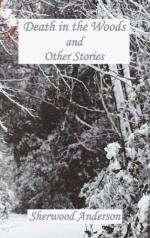|
This section contains 3,189 words (approx. 11 pages at 300 words per page) |

|
SOURCE: “The Man, the Boy, and the Myth: Sherwood Anderson's ‘Death in the Woods’”, in Midcontinent American Studies Journal, Vol. 3, No. 2, Fall, 1962, pp. 48–54.
In the following essay, Rohrberger offers a symbolic reading of “Death in the Woods,” which, according to Rohrberger, alludes to ancient myths of death and rebirth, as the narrator's recollection of past events harkens back to a prehistoric antecedent and the depths of civilization itself.
Sherwood Anderson's “Death in the Woods” is, as Irving Howe notes, “bare as a winter tree,” but “marvelously rich in substance,”1 for beneath the surface level of narration and by means of a pattern of symbols Anderson ponders the ultimate reality of life and death. The narrator of the story is a man, but he recounts past experiences, some of which have taken place when he was a boy. The tale which he tells is on the surface level a...
|
This section contains 3,189 words (approx. 11 pages at 300 words per page) |

|


